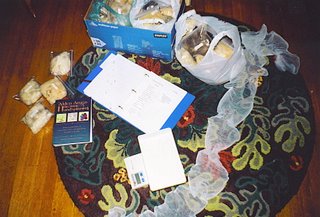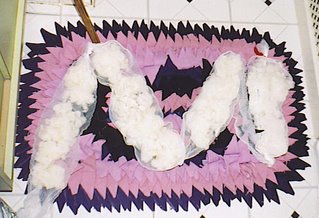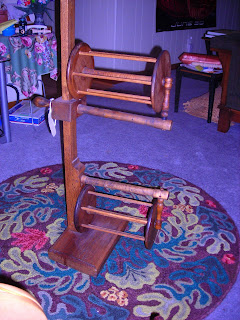I began learning how to spin about 8 years ago. At various times in my short spinning career I've heard talk of fleece studies: a group of spinners gets together, collectively buys several fleeces, and then splits each fleece up and distributes it among the group. It's a great way for an individual to learn about the wool from different breeds of sheep without committing to a whole fleece from each one. This method works best with a large group, and although there was talk of doing a fleece study in my old guild, I never managed to get into one. Happily, I've sort of fallen into one here in Buffalo. I've been bringing my wheel along to a once a week informal knitting group at Raveloe Fibers. A month or two ago Donna asked me if I'd be interested in joining the fiber study she was starting. Would I!!!I have to give big kudos to Donna for starting this whole thing and organizing it. I don't know how she initially found out about it, but she has discovered a much better way to do a fleece study, which is to start at Jacqueline Bland's website. Jackie does all the purchasing, splits up the fleeces into 1 ounce samples--all in little sandwich bags, and mails it out to you, complete with a binder full of information and worksheets for each breed represented. Had we done this on our own, the twelve of us in the group might have purchased 6 fleeces, and might still have been overwhelmed. By doing Jackie's study we will each get to work with samples of over 40 different fleeces, and did I mention the binder full of info?
Our plan is to work with all the information we can find in books and on the internet as well as learning from our own experience and from each other. I'm posting my process here as a resource to the group and anyone else who may find it helpful. I realized after our initial conversations that many experienced spinners have only worked with prepared roving and have never had to begin by washing or carding their wool, so I've included these photos to help illustrate that part of the process. Here's what I began with. At the top left is the box that contained the full study. Two larger bags of samples are still in it. To the right of the box is the third bag of samples and below the box is the binder. To the left on the hardwood floor are baggies of the first four samples we're working with, Cormo, Merino, Rambouillet, and Polwarth. The book is The Alden Amos Big Book of Handspinning an invaluable tome on the full subject of spinning. I find myself going back to this book every time someone in the group asks just about any spinning question. Also pictured is a digital kitchen scale which I used to weigh each sample before and after washing ( to determine just how much of my dirty fleece is dirt) and to weigh out the right amount of soap to use. That weird long white net type object is a bath poof that has had it's inner tie clipped. That was one of the brilliant suggestions from Jackie. If you take apart a poof you get a really long mesh tube, which is perfect for keeping small samples separate while washing.
Here's what I began with. At the top left is the box that contained the full study. Two larger bags of samples are still in it. To the right of the box is the third bag of samples and below the box is the binder. To the left on the hardwood floor are baggies of the first four samples we're working with, Cormo, Merino, Rambouillet, and Polwarth. The book is The Alden Amos Big Book of Handspinning an invaluable tome on the full subject of spinning. I find myself going back to this book every time someone in the group asks just about any spinning question. Also pictured is a digital kitchen scale which I used to weigh each sample before and after washing ( to determine just how much of my dirty fleece is dirt) and to weigh out the right amount of soap to use. That weird long white net type object is a bath poof that has had it's inner tie clipped. That was one of the brilliant suggestions from Jackie. If you take apart a poof you get a really long mesh tube, which is perfect for keeping small samples separate while washing.
 Here are the four samples ready for the first scour. I opened up each sample by pulling the wool apart and spreading out any tangled together locks. Then I stuffed then into the tube one by one with lots of space for each to move in and a knot in between the samples. I tied a piece of red yarn at one end to identify it as the beginning. I wrote down the order of the samples starting from the end with the red yarn so I could keep track of them throughout the process.
Here are the four samples ready for the first scour. I opened up each sample by pulling the wool apart and spreading out any tangled together locks. Then I stuffed then into the tube one by one with lots of space for each to move in and a knot in between the samples. I tied a piece of red yarn at one end to identify it as the beginning. I wrote down the order of the samples starting from the end with the red yarn so I could keep track of them throughout the process.
If I were washing a full fleece, I would have filled my bathtub half full of 110-120 F (43-49 C) water and scoured it in about 1lb batches with 4oz of orvus paste in each tub full, but since the samples here only add up to about 4oz of wool, I filled the tub to about a quarter full and used 2oz of orvus.
I did make one big mistake on this first batch of wool, which was that I underestimated the alkalinity of orvus paste. I added a significant quantity of washing soda, which made my scouring liquid much too alkali and damaged the wool. The washed wool broke easily when I held either end of a lock and gently pulled, and tended to break when I carded it, making for a lumpier preparation than I wanted. I washed later batches with just the orvus paste and got squeaky clean wool with no breaks.
The water temperature is important, as it has to be hot enough to melt the suint in the wool, but not so hot as to damage it. 110-120F is ideal. It's best if you use a thermometer, but in a pinch you can tell that you're in the ball park if you've used tap water hot enough that you can't keep your hand in it for very long.

For the first scour, fill the tub with water, add the orvus paste (2oz for a quarter full tub, 4oz for half full) and drop your dirty wool in one end. Now slowly herd the wool from one end to the other with some sort of stick or pole. This is a slow herd to move the scouring liquid through the wool with as little agitation as possible so you don't accidentally felt it. It should take you about a minute to get to the other end of the tub. Herd back to the beginning and forth and back one more time. I started this batch at the right end of the tub and am moving it to the left. You can see that the water it has already passed through at the right is pretty filthy, while the left end of the tub is still clear. If you are washing a lot of wool (like a whole fleece) you can pull the first batch out and set it in an old strainer to drain while you run one more batch of wool through this water. After the second batch drain the tub. Since I was only washing one batch, I drained the tub right away while the wool was dripping in the strainer.
 The second scour is just like the first scour, same amount of water and soap, same temperature, same herding with the stick. The only difference is that the water will be much cleaner because most of the dirt and suit came out in the first scour. If you are washing a whole fleece, you can put two batches of wool through the second scour bath too, but this time let the 2nd batch be the first so it gets a shot at the clean water.
The second scour is just like the first scour, same amount of water and soap, same temperature, same herding with the stick. The only difference is that the water will be much cleaner because most of the dirt and suit came out in the first scour. If you are washing a whole fleece, you can put two batches of wool through the second scour bath too, but this time let the 2nd batch be the first so it gets a shot at the clean water.
The rinse water should be the same temperature as the two scours. You can do the herding again through the rinse. I have to admit I wandered off to make a cup of tea and let it sit still for a minute, then herded a bit, which worked out just fine. If doing a whole fleece you can put two batches through the rinse together.
Pull the clean wool out of the rinse water and let it drain. After it has drained you can grab all the knots together in one hand and fling the whole dripping mess around in big circles letting centrifugal force (actually a combination of centripetal force and straight line motion) remove most of the water from the wool. Either do this outdoors or leaning into your shower with the curtain most of the way closed to protect you and the bathroom from getting soaked. I laid out the clean wool on a towel on top of a drying rack in front of my radiator and it was dry within 24 hours.
 Check out how white the clean wool is. I laid it out on the same bathroom rug so you can see the color difference between dirty and clean.
Check out how white the clean wool is. I laid it out on the same bathroom rug so you can see the color difference between dirty and clean.
This is all pretty much Alden Amos's method as laid out in his book. I've given more specific information about the brand and quantity of soap I used and how I dealt with the samples instead of a full fleece. He goes into much more detail about each step and why it's necessary, which is definitely worth reading.
 When Scott asked what I wanted to make, the first explanation I gave him was "a fancy stick." An apt description, yes? This is an ingenious and very old Scandinavian tool for winding a perfect center pull ball of yarn. Mine is made out of tulip wood and includes my addition of a yarn gauge at the end of the handle.
When Scott asked what I wanted to make, the first explanation I gave him was "a fancy stick." An apt description, yes? This is an ingenious and very old Scandinavian tool for winding a perfect center pull ball of yarn. Mine is made out of tulip wood and includes my addition of a yarn gauge at the end of the handle. It's hard to tell from the photo I snapped quickly at work, but that is a perfect little ball of yarn that looks like it came off a ball winder. and look at the beautiful grain on that wood! I have enough wood for a second nostepinne, so I am refining my design and will start another, maybe in January.
It's hard to tell from the photo I snapped quickly at work, but that is a perfect little ball of yarn that looks like it came off a ball winder. and look at the beautiful grain on that wood! I have enough wood for a second nostepinne, so I am refining my design and will start another, maybe in January.



















































